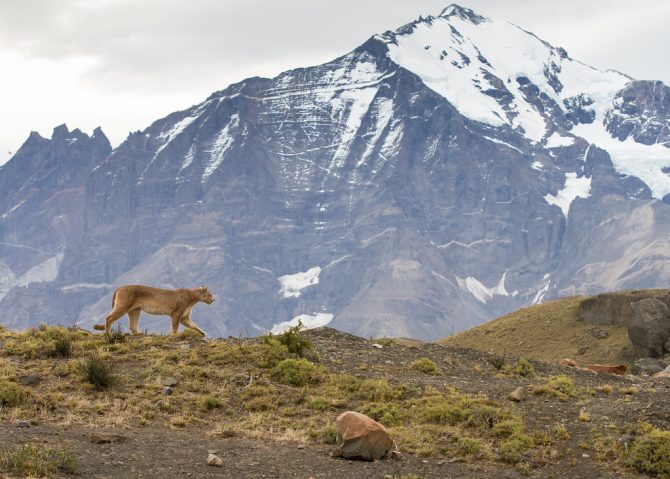Next to me sit two fat books, over 1,500 Pulitzer Prize-winning pages, on J. Robert Oppenheimer and the atomic bomb. Which with some effort I will now push aside, despite my interest in the matter. There are other issues of importance at hand.

Two new titles on the theme of wilderness have held my attention lately: A Wild Idea, a biography of businessman-adventurer turned ecological crusader Doug Tompkins; and writer David Quammen's latest, The Heartbeat of the Wild. Very different, but with some unexpected overlap on their way to a shared message: earthlings (not just us naked apes) need more big, quality chunks of wild lands and waters - and attention must also be paid to the areas outside of such chunks.
David Quammen is one of my favorite natural history writers, but I discovered something while reading his new book: while all his books are engaging and educational, I like his early short essays more than his recent works (with an exception or two). The Heartbeat of the Wild is a collection of pieces published in National Geographic over the past twenty years, and that’s what led me to this conclusion. Which is to say, it's not as light, quirky, and humorous as his older collections of pieces written for Outside magazine, the ones with titles like The Flight of the Iguana, The Song of the Dodo, and The Boilerplate Rhino. That said, if you're not a NatGeo reader, Heartbeat contains much that's new and interesting from places far and wide, from the heart of Africa to the tip of South America and on to northeastern Russia.
In fact, it's not really a natural history book. Quammen explains in the foreword that it's about people committed to preserving the heartbeat of the wild. Names familiar and not so much, like E.O. Wilson, Jane Goodall, Mike Fay, and Greg Carr show up. Doug Tompkins merits a chapter, shared with his wife Kris.
It becomes clear that people hear the heartbeat of the wild differently, and approaches to keeping it strong vary, well, wildly. A large part of the joy of reading Quammen is his first-person experiences with these intrepid adventurers, workers, and entrepreneurs, whether it’s taping one's feet properly on a miles-long slog through the mud (in sandals or even barefoot, certainly not in hiking boots), as a passenger on a small plane flying low over the jungle, or boating and trekking amongst polar bears in the Russian far north. Sometimes a little too closely amongst said bears.
Quammen suggests, essentially, "If it's the Congo, count me in." Why? Because, despite nearly a century of colonial rule and the accompanying resource extraction and ecological degradation, large parts of it are still about as wild as it gets on this planet. When asked if he would accompany botanist-explorer Mike Fay on his “Megatransect,” a thousand mile-plus survey of the wilds of the Republic of the Congo -- on foot -- Quammen jumped at the chance. He subsequently called it "The Long Follow."
Later he accompanied Fay on an aerial transect, flying an invisible grid over acres and acres of African jungles, wetlands, and deserts. Quammen has made numerous trips to Africa, chasing stories of everything from elephants to Ebola, but flying above the landscape offers surprising new perspectives.
Another fan of the aerial view, we learn in A Wild Idea, is Doug Tompkins. Indeed, it turns out that one of the pilots for Mike Fay's "Megaflyover" was none other than he. Tompkins, the high school drop-out self-made millionaire capitalist with a wild streak, who started The North Face and, with his wife, Esprit, is the subject of Jonathan Franklin's fascinating new book.
Tompkins, a guy you either disliked or liked a lot, had in the late 1980s what his friend Wes Jackson would somewhat jokingly call a "come to Jesus moment." As he read books like Deep Ecology and learned more about the wild lands he loved to explore, he realized that the more successful he was as a capitalist, the more he was ruining them. So he removed himself from it, and moved to land he purchased far to the south, in Patagonia.
Then he bought some nearby acres, and then he bought millions more. For a time he and his wife Kris were the largest private landowners in the world. What they did later is mind-blowing -- after years of land purchases and consolidations, fence removals, political fights, natural disasters, species re-introductions, and more land purchases, Doug and Kris gave most of it away to Chile and Argentina as National Parks.
Franklin brings a wealth of details into Tompkins' story, and it makes for great reading. I met Tompkins a couple of times, thanks to his friendship with Wes Jackson and visits to the Land Institute in Salina in the 1990s and early 2000s, and I'll admit that I am one of the skeptics. Or at least I was until I read this book and learned more about him. I don't think we would have gotten along too well, but I am much impressed by what he accomplished.
Doug Tompkins died at 72 in 2015, kayaking with good friends in Lake Carrera, on the border of Chile and Argentina, when a fierce storm moved in and overturned his boat. He fought in frigid waters for two hours, but didn't make it. His body heat when he finally was rescued and airlifted to a hospital was 69 degrees.
David Quammen's penultimate chapter is on Tompkins, and he wraps up The Heartbeat of the Wild with the reminder that though people are the problem, people are the only solution.
(The two titles mentioned in paragraph one: The Making of the Atomic Bomb and American Prometheus )
-Jake Vail is an Information Services Assistant at Lawrence Public Library.


Add a comment to: Wild Times